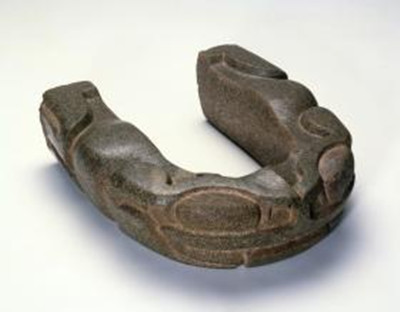(单词翻译:单击)
I'm in the Mexican gallery in front of what looks like a giant stone horseshoe-it's about 20 inches (50 cm) long and about 4 inches (10 cm) thick and is made of a very beautiful grey-green speckled stone. When it first came to the British Museum in the 1860s they thought that it was a yoke for something like a carthorse-but there were two immediate problems with this theory: first the object is very heavy, it's about five or six stone (35 kg)-too heavy even for a horse's neck-and secondly, there were no carthorses or draught animals in Central America until the Spaniards brought them from Europe in the sixteenth century.
在大英博物馆的墨西哥厅,有一件形似大型石制马蹄铁的物品,长约四十厘米,厚十二厘米,由美丽的灰绿色斑点石制成。1860年它刚到大英博物馆时,人们以为它是马匹之类的拉车的轭。但很快疑问便出现了:首先,这件东西重约四十千克,背起来过于沉重;其次,在16世纪西班牙人进入美洲之前,美洲其实没有任何用于负重拉拽的动物。
It was only just over 50 years ago that it was generally understood that these stone carvings had nothing to do with animals; they were meant to be worn by men. They represent the padded belts made of cloth or basketwork worn to protect the hips during ancient Central American ball games. Indeed some of these stone belts may have been moulds used to shape lighter cloth or leather padding, but the one we have in the British Museum is made of solid stone, so heavy that if it was worn it can only have been very briefly. Nowadays it would perhaps be for a quick photo call, but we don't actually know exactly when or how it might originally have been worn.
直到五十多年前,人们制品与动物无关,而是给人类穿戴的。它类似用布的软垫,戴在腰间,在古代中美洲的球类运动中用于保护臀部。有些石头腰带可能只是模具,成品则由较轻的布料或皮革制成。而大英博物馆所藏的这一件也太过沉重,即使戴不了太长时间。我们无法准确了解古人佩戴它的原因何在,也不了解他们在什么情况下会佩戴它,又是如何佩戴的。
We asked the leading expert on these games, Michael Whittington, what he thought these stone belts were for:
中美洲球类运动专家迈克尔惠廷顿认为,这些腰带主要是在仪式使用的:
"I believe these were ceremonial objects.Wearing an object that's 75-100 lbs around your waist during an athletic competition will slow you down considerably, so they probably were worn as part of the ritual ceremonies at the beginning of the game.
我认为这些是仪式用具。在运动比赛中戴着三四十公斤重的东西会让人动作变慢。因此应该是在比赛前的宗教仪式中使用的。它们象征着比赛中人们真正会使用的腰带。



